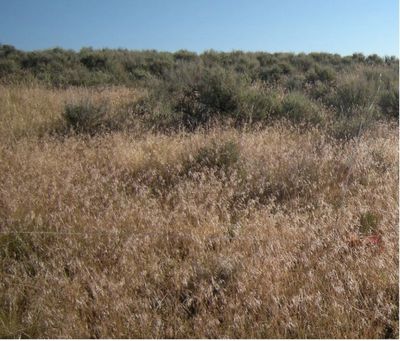Cheatgrass Mitigation
Ecology
Non-native cheatgrass cheats farmers and ranchers out of their land 100+ million acres affected More than 100 million acres of land in the western United States are infested with cheatgrass, making it the most abundant invasive species in the nation. As its name implies, cheatgrass cheats landowners and ranchers from earning the full economic benefit of their land by displacing native plants, reducing biodiversity, and spreading fires. According to Cornell University researchers, invasive species such as cheatgrass cost the nation some $138 billion annually in ecosystem damages, reduced yields, lost forest products, and control efforts. Cheatgrass is the name for several types of annual brome grasses. The most common type, downy brome (Bromus tectorum), is most prevalent in Idaho, Nevada, and Utah, where it has turned massive and once-flourishing rangelands into arid, desolate fields. Cheatgrass is an aggressive invader of sagebrush, pinyon juniper, ponderosa pine, mountain brush, and other rangeland and forest communities. Its ability to rapidly grow and reproduce before most native grasses makes it especially troublesome on range, croplands, and pastures. Cheatgrass can alter the normal fire pattern in vegetated areas when its populations become dense and dominant. After wildfire, cheatgrass thrives and can out-compete native herbaceous and shrubby seedlings such as antelope bitterbrush. The presence of cheatgrass with its awned seed can diminish recreational opportunities, reduce available forage, degrade wildlife diversity and habitat, and decrease land values.
In an effort to provide landowners with quality service backed by modern science and proven methods, Range Rescue LLC, will consult with NRCS or University County Extension agents to formulate a plan of action on all potential private contracts. We recommend the landowner be involved in the consultation process.
An Integrated Management program is the most effective approach to reducing and controlling Cheatgrass and other invasive summer annuals.
Range Rescue process for contractual agreement and fulfillment
* Meet with landowner or representative for site visit to clearly define goals and objectives.
* Site visit with NRCS or University Extension Agent to formulate plan of action.
* Submit Bid Proposal to landowner
Example of Plan of Action
* If possible, prescribed livestock grazing in the spring in target area. Grazing should occur when cheatgrass is tall enough to be accessible to the livestock, but prior to plants turning purplish-red so as to prevent seed production. At least two defoliations each spring are required to minimize cheatgrass seed production.
* Mid to late summer mowing of target area if brush is present as part of preparation for rangeland drill seeding and herbicide application.
* Fall application of Plateau herbicide prior to fall emergence. Application rate is 8oz per acre applied in 20 gallons of water per acre. (Plateau® (imazapic) provides control of cheatgrass and its selective activity allows many desirable native grasses and forbs to re-establish after treatment. For the most effective control of cheatgrass, late summer or fall applications of Plateau® herbicide, preemergent to early post-emergent, are recommended.)
* Early the following spring - Rangeland drill seed mix customized to meet goals and objectives defined in plan of action.
* Restrict grazing until establishment of new seeding.
* Monitor results, plan for fall application of Plateau herbicide if necessary

Copyright © 2025 Range Rescue LLC - All Rights Reserved.